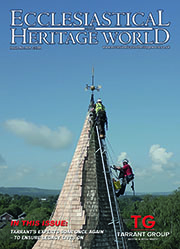Historic England helps Boston build on its past
 By raising awareness of Boston's historic significance and encouraging investment in a series of conservation projects, Historic England has helped this Lincolnshire town to capitalise on its past.
By raising awareness of Boston's historic significance and encouraging investment in a series of conservation projects, Historic England has helped this Lincolnshire town to capitalise on its past.
Boston reached its zenith in the medieval period when it was the second busiest port in Britain, but decreasing wool exports led to its decline. Although enjoying a revival in the 18th and 19th centuries, by the 20th century the silting of the Haven and a shift in trade routes transformed Boston from international trading hub to remote coastal town.
In spite of some insensitive redevelopment in the 1960s and 70s, Boston managed to retain much of its historic appeal, but lack of investment and a poor understanding of its fabulous architecture meant that this thriving market town was not living up to its true potential.
By working closely with the town's key stakeholders, Historic England has been able to transform the fortunes of many of its important historic buildings and areas.
The Market Place forms the commercial heart of Boston, but in 2010 many of the buildings here were in a poor state of repair and this conservation area was added to the Heritage at Risk Register.
Historic England responded by launching an area grant scheme to help regenerate the area. A cash injection of £200,000 resulted in historic shop fronts being reinstated as part of a comprehensive public realm scheme for the Market Place that also reinstated the historic, ornate "Five Lamps" feature.
Through their advice and financial support No.116 High Street, the first bank in Lincolnshire dating from the early 18th century which was in a near state of collapse, was saved and turned into offices.

The first book to examine a whole range of buildings in Boston, Lincolnshire. Price £14.99. Click here for more information.
Historic England have also contributed towards the repair of seven buildings in the town's conservation area, including part of the first purpose built shopping parade in the country, dating from the 18th century.
Their input into design proposals to replace an ugly post-war makeshift bridge next to the Grade I St Botolph's Church, has resulted in a stylish new bridge using a modern bowstring construction that enhances the setting of this historically important church.
Many of Boston's buildings have had their listings upgraded, such as the early 19th century Sessions House, now Grade II*, revealing its full historic significance and strengthening its protection.
Historic England has also helped to promote the town's impressive history and heritage by publishing a book, Boston, Lincolnshire - Historic North Sea Port and Market Town, tracing Boston's development and exploring its distinctive character.
A community dig, a joint initiative involving Historic England, the HLF and the County Council, examined the archaeological legacy of Boston and raised awareness, particularly amongst the general public, of the importance of the town's heritage.
Today Boston's distinctive historic townscape is recognised as the bedrock of the town's future prosperity.
For further information on Historic England visit www.historicengland.org.uk














